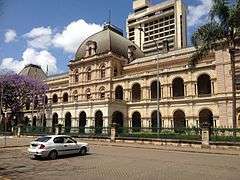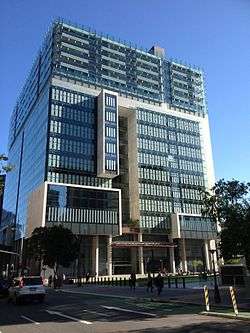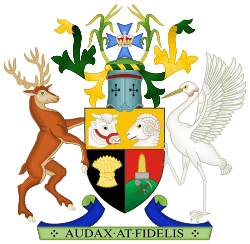Government of Queensland
|
Emblem of the Queensland Government and its agencies | |
|
Coat of arms of the State of Queensland, used for formal and ceremonial purposes. | |
| Formation |
|
|---|---|
| Australian state | Queensland |
| Website | http://www.qld.gov.au/ |
| Legislative branch | |
| Legislature | |
| Meeting place | Parliament House |
| Executive branch | |
| Main organ | Cabinet of Queensland |
| Leader | Premier |
| Appointer | Governor |
| Meeting place | Parliament House |
| Judicial branch | |
| Court | Supreme Court |
| Seat | Brisbane |
The Government of Queensland, also referred to as the Queensland Government, is the Australian state democratic administrative authority of Queensland. The Government of Queensland, a parliamentary constitutional monarchy, was formed in 1859 as prescribed in its Constitution,[1] as amended from time to time. Since the Federation of Australia in 1901, Queensland has been a state of the Commonwealth of Australia, and the Constitution of Australia regulates its relationship with the Commonwealth. Under the Australian Constitution, Queensland ceded legislative and judicial supremacy to the Commonwealth, but retained powers in all matters not in conflict with the Commonwealth. Key state government offices are located at 1 William Street in the Brisbane central business district.
Executive and judicial powers



The Government of Queensland operates under the Westminster system, a form of parliamentary government based on the model of the United Kingdom. The Governor of Queensland, as the representative of the Monarch, holds nominal power, although in practice only performs ceremonial duties. The Parliament of Queensland holds legislative power, while executive power lies with the Premier and Cabinet, and judicial power is exercised by a system of courts and tribunals.
The Parliament of Queensland is the state's legislature. It consists of the Monarch (represented by the Governor), and a single chamber; the Legislative Assembly. Queensland is the only Australian state with a unicameral parliament after a second chamber, the Legislative Council, was abolished in 1922.
The Legislative Assembly has 89 members; one representing each electoral district in Queensland. Elections for the Legislative Assembly are held approximately every three years.
The Cabinet of Queensland is the government's chief policy-making organ, and consists of the Premier and all ministers.
Current Ministry
| Minister | Office | Portrait |
|---|---|---|
| Annastacia Palaszczuk |
|
|
| Jackie Trad |
|
 |
| Curtis Pitt |
|
|
| Cameron Dick |
|
|
| Kate Jones |
|
|
| Yvette D'Ath |
|
|
| Bill Byrne |
|
|
| Anthony Lynham |
|
|
| Stirling Hinchliffe |
|
|
| Mark Bailey |
|
|
| Steven Miles |
|
|
| Grace Grace |
|
|
| Coralee O'Rourke |
|
|
| Leeanne Enoch |
|
|
| Shannon Fentiman |
|
|
| Leanne Donaldson |
|
|
| Mick de Brenni |
|
|
| Assistant Ministers | ||
| Mark Ryan |
|
|
| Jennifer Howard |
|
|
Queensland government agencies
The Queensland Government delivers services, determines policy and regulations, including legal interpretation, by a number of agencies grouped under areas of portfolio responsibility. Each portfolio is led by a government minister who is a member of the Parliament. As of April 2016 there were ninteen lead agencies, called government departments, that consist of:[2]
- Department of the Premier and Cabinet
- Department of Aboriginal and Torres Strait Islander Partnerships
- Department of Agriculture and Fisheries
- Department of Communities, Child Safety and Disability Services
- Department of Education and Training
- Department of Energy and Water Supply
- Department of Environment and Heritage Protection
- Queensland Health
- Department of Housing and Public Works
- Department of Infrastructure, Local Government and Planning
- Department of Justice and Attorney-General
- Department of National Parks, Sport and Racing
- Department of Natural Resources and Mines
- Queensland Police Service and Queensland Fire and Emergency Services
- Department of Science, Information Technology and Innovation
- Department of State Development
- Department of Transport and Main Roads
- Queensland Treasury
- Department of Tourism, Major Events, Small Business and the Commonwealth Games
A range of other agencies support the functions of these departments.
Judiciary

The judiciary of Queensland consists of the Magistrates Court, the District Court, and the Supreme Court, as well as a number of smaller courts and tribunals. The Chief Justice of Queensland is the state's most senior judicial officer.
Magistrates Court
The Magistrates Court is the lowest tier of the judicial hierarchy of Queensland.[3] The court's criminal jurisdiction covers summary offences, and indictable offences which may be heard summarily, but all criminal proceedings in Queensland begin in the Magistrates Court, even if they are not within this jurisdiction.[4] For charges beyond its jurisdiction, the court conducts committal hearings in which the presiding magistrate decides, based on the strength of the evidence, whether to refer the matter to a higher court or dismiss it.[4] The court's civil jurisdiction covers matters in which the amount in dispute is less than or equal to $150,000.[4] Appeals against decisions by the Magistrates Court are heard by the District Court.[4]
District Court
The District Court is the middle tier of the judicial hierarchy of Queensland.[5] The court has jurisdiction to hear all appeals from decisions made in the Magistrates Court.[5] Its criminal jurisdiction covers serious indictable offences (such as armed robbery, rape, and dangerous driving).[5] The court's civil jurisdiction covers matters in which the amount in dispute is more than $150,000 but less than or equal to $750,000.[5] Appeals against decisions by the District Court are heard by the Court of Appeal, a division of the Supreme Court.[5]
Supreme Court
The Supreme Court is the highest tier of the judicial hierarchy Queensland.[6] The court has two divisions; the Trial Division and the Court of Appeal. The Trial Division's jurisdiction covers serious criminal offences (including murder and manslaughter), and civil matters involving claims of more than $750,000. The Court of Appeal's jurisdiction allows it to hear cases on appeal from the Trial Division, the District Court, and a number of other judicial tribunals in Queensland.[6] Appeals against decisions by the Court of Appeal are heard by the High Court of Australia.
See also
References
- ↑ "Q150 Timeline". Queensland Treasury. Retrieved 28 October 2011.
- ↑ "Queensland Public Service Commission - A summary of changes to departments of government" (PDF). The State of Queensland. Retrieved 19 February 2015.
- ↑ Department of Justice and Attorney-General (Queensland) (2012). "Magistrates Court". Retrieved 14 March 2014.
- 1 2 3 4 Department of Justice and Attorney-General (Queensland) (2010). "Magistrates Court of Queensland" (PDF). Retrieved 14 March 2014.
- 1 2 3 4 5 Department of Justice and Attorney-General (Queensland) (2010). "The District Court of Queensland" (PDF). Retrieved 14 March 2014.
- 1 2 Department of Justice and Attorney-General (Queensland). "Supreme Court". Retrieved 14 March 2014.
External links
| Wikimedia Commons has media related to Government of Queensland. |
| Wikisource has original text related to this article: |
- Queensland Government web site
- List of Queensland Government non-departmental bodies
- Get involved — Queensland Government community engagement website.
- Queensland Parliament
- The Premier of Queensland


